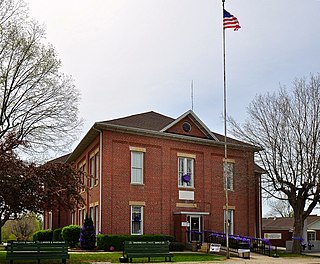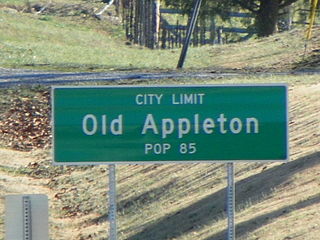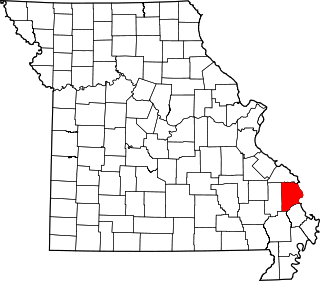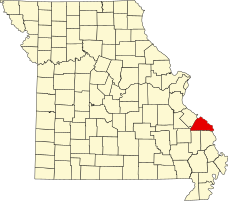
Perry County is a county located in the southeastern portion of the U.S. state of Missouri. As of the 2020 census, the population was 18,956. Its county seat is Perryville. The county was officially organized on November 16, 1820 from Ste. Genevieve County and was named after Oliver Hazard Perry, a naval hero of the War of 1812.

Bollinger County is a county located in the southeastern part of the U.S. state of Missouri. As of the 2020 census, the county's population was 10,567. The county seat is Marble Hill. The county was officially organized in 1851.

Pocahontas is a village in Cape Girardeau County, Missouri, United States. The population was 97 at the 2020 census. It is part of the Cape Girardeau–Jackson, MO-IL Metropolitan Statistical Area.

Ste. Genevieve is a city in Ste. Genevieve Township and is the county seat of Ste. Genevieve County, Missouri, United States. The population was 4,999 at the 2020 census. Founded in 1735 by French Canadian colonists and settlers from east of the river, it was the first organized European settlement west of the Mississippi River in present-day Missouri. Today, it is home to Ste. Genevieve National Historical Park, the 422nd unit of the National Park Service.

Old Appleton is a village in Cape Girardeau County, Missouri, United States. The population was 73 at the 2020 census. It is part of the Cape Girardeau–Jackson, MO-IL Metropolitan Statistical Area.

The Shawnee are an Indigenous people of the Northeastern Woodlands. Their language, Shawnee is an Algonquian language.

Pierre-Louis de Lorimier, usually Anglicized to Peter Loramie, was a colonial French-Canadian fur trader, British Indian agent, Shawnee agitator, and in later years, founded Cape Girardeau and Bollinger Counties, Missouri. He died in Cape Girardeau, MO. and was buried there with his Indian wife.
Black Bob was a Native American Shawnee Chief. His band was a part of the Hathawekela division of the Shawnee. He was known for being one of the last Shawnee to resist leaving for the Indian Territory, and for keeping his band together until his death, holding their lands in common, as they moved between Missouri, Arkansas, and the Black Bob Reservation in Kansas.

The Treaty of Fort Clark was signed at Fort Osage on November 10, 1808, in which the Osage Nation ceded all the land east of the fort in Missouri and Arkansas north of the Arkansas River to the United States. The Fort Clark treaty and the Treaty of St. Louis in which the Sac (tribe) and Fox (tribe) ceded northeastern Missouri along with northern Illinois and southern Wisconsin were the first two major treaties in the newly acquired Louisiana Purchase. The affected tribes, upset with the terms, were to side with the British in the War of 1812. Following the settlement of that war, John C. Sullivan for the United States was to survey the ceded land in 1816 (adjusting it 23 miles westward to the mouth of the Kansas River to create the Indian Boundary Line west of which and south of which virtually all tribes were to be removed in the Indian Removal Act in 1830.
On the eve of the American Civil War in 1861, a significant number of Indigenous peoples of the Americas had been relocated from the Southeastern United States to Indian Territory, west of the Mississippi. The inhabitants of the eastern part of the Indian Territory, the Five Civilized Tribes, were suzerain nations with established tribal governments, well established cultures, and legal systems that allowed for slavery. Before European Contact these tribes were generally matriarchial societies, with agriculture being the primary economic pursuit. The bulk of the tribes lived in towns with planned streets, residential and public areas. The people were ruled by complex hereditary chiefdoms of varying size and complexity with high levels of military organization.

Fenwick Settlement is an abandoned village in Perry County, Missouri, United States. The community was named after the Fenwick family, who were early settlers on the left bank of the Mississippi River in the Spanish Illinois Country.

Bois Brûlé is one of the eight townships located in Perry County, Missouri, in the United States of America.

Union is one of the eight townships located in Perry County, Missouri, in the United States of America.

Shawneetown is an unincorporated community in Shawnee Township in northern Cape Girardeau County, Missouri, United States. It is located twenty miles north of Cape Girardeau and is part of the Cape Girardeau–Jackson, MO-IL Metropolitan Statistical Area.

Le Grand Champ is is an alluvial floodplain, also called a bottom, extending along the Mississippi River in Ste. Genevieve County, Missouri.

Apple Creek is a stream that rises in western Perry County, Missouri and empties into the Mississippi River, forming the boundary between Perry and Cape Girardeau counties.

The Colonial history of Missouri covers the French and Spanish exploration and colonization: 1673–1803, and ends with the American takeover through the Louisiana Purchase
The Treaty of St. Louis is the name of a series of treaties signed between the United States and various Native American tribes from 1804 through 1824. The fourteen treaties were all signed in the St. Louis, Missouri area.

Manuel Perez was the Lieutenant Governor of Illinois between November 1787 and 1792.

Quatawapea or John Lewis, also known as Captain Lewis and Colonel Lewis and ‘’’Captain Johnny’’’, was a Shawnee leader for whom Lewistown, Ohio, is named. Lewis fought in the American Revolutionary War (1775–1783) and the Northwest Indian War (1785–1795) as part of Shawnee opposition to the expansion of the United States into Shawnee territory. After the 1795 Treaty of Greenville, he sought to preserve Shawnee autonomy by promoting accommodation with the U.S., working with Black Hoof, the principal Shawnee spokesman.
















